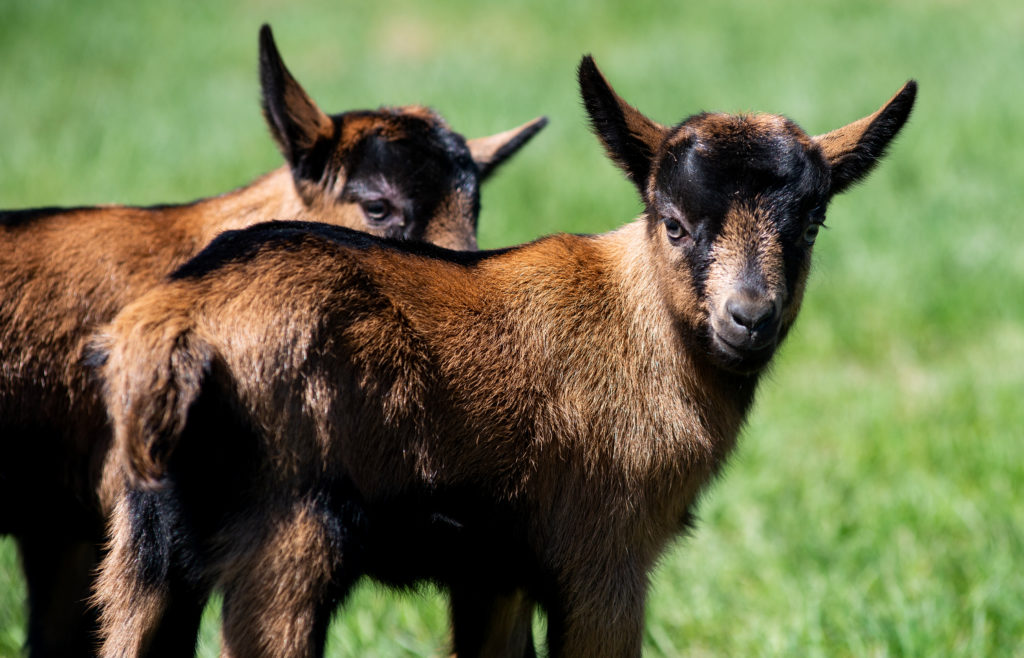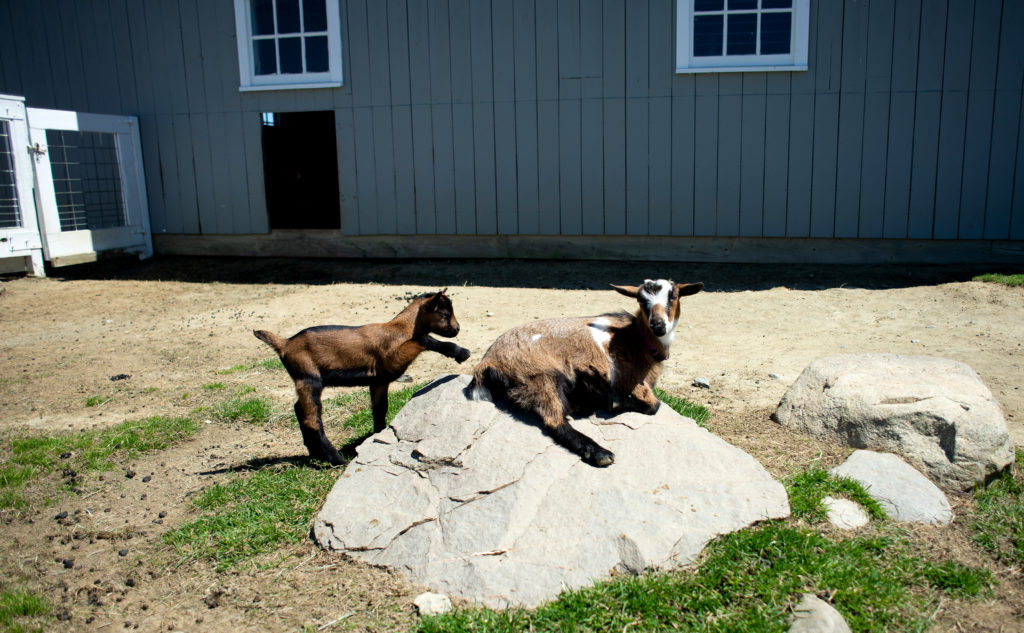Thinking of raising goats? Here’s what you need to know before you do

Maybe you visited a petting zoo or a local farm. Perhaps you want to take control of your own dairy, meat or fiber production. Whatever the reason, you have decided the time is right to start raising goats on your homestead.
You are not alone. According to the most recent data from the United States Department of Agriculture, published in February 2019, there are goat farmers in every state — including Alaska — raising the animals for meat, milk, fiber, brush control or as pack animals. The collective national goat herd numbers 2,622,000.
But there are a few things to consider before you start raising goats.
The value of mentors and research
Before even shopping for a goat, do your research. Beginning by asking yourself what it is about raising goats that intrigues you. Do you want to raise goats for milk? Fiber? Something else?
Libraries have books, magazines and other periodicals devoted to raising goats. The vetted information is a good place to start. You can also look to reputable sites online including the American Dairy Goat Association and the American Goat Federation, for information on raising goats.
Connecting directly with goat farmers who might be willing to be your goat mentor is another great way to research. Active goat farmers love few things more than talking about their goats, so there’s a wealth of knowledge to tap into.
“One of the most important things you can do is spend time with people who have ‘been there and done that’ with goats,” said Thomas Cox, dairy goat farmer in Maine and a director and licensed goat judge with the American Dairy Goat Association. “Find a mentor that can point you in the right direction.”
To connect with goat farmers, check with your state department of agriculture or your state university Cooperative Extension office to see if they have lists and contact information on area farmers. Attend county or state fairs to meet up with people who raise and show goats.
“You want to have as much information as possible before getting a goat,” he said. “Try to visit farms that have goats and don’t be afraid to ask lots of questions.”
Decide what you want from raising goats
When it comes to livestock, few animals have more uses than a goat.
“Goat meat is the most consumed protein in the world,” Cox said. “They are also good for milk, for their hair and they can be really great companion animals.”
Robin Brann of Vassalboro, Maine, is just a year into having goats and learned the diverse uses for the animals before one set a hoof on her farm.
“I am an avid researcher,” Brann said. “I started reading about [goats] and then talking to people who had them and started thinking it would be fun to have a goat.”
She planned to invest in a dairy goat or two with her sister-in-law. They would learn how to milk a goat.
“We figured it would be nice to have the goat milk with our eggs,” Brann said. “I’d have them on my farm [and] I already had 30 chickens and plenty of room for goats.”
Brann and her sister-in-law enjoyed milking their four goats. They are now beginning to transition the small herd over to fiber-producing goats, to lessen the labor associated with milking and having to breed goats every year.
There is no such thing as ‘one goat’

One important thing that all would-be goat owners need to know: Goats are a herd animal which means you can’t have a solitary goat on your homestead. A lone goat will become a depressed goat and will look for anything to cheer itself up, according to Pat Polley, president of the Maine Boer Goat Breeders. This often leads to destructive or aggressive behavior from what should be a docile homestead animal.
“I recommend having at least three goats,” Polley said. “Because what if something happens to one? You don’t want just one left alone.”
On homesteads with diversified livestock, a single goat will buddy up with a cow, pony or dog. Polley said, which is fine. The important thing is for the goat to have a friend.
Care and feeding of your goat
Goats don’t require a great deal of daily attention, but it has to be consistent, according to Polley.
“If you have just a couple of goats, plan on spending about 30 minutes a day with them feeding and watering,” Polley said.
Of course, the more time and attention lavished on the goats, the happier and healthier they will be.
Tips for raising goats
The American Goat Federation lists multiple links to land grant universities and cooperative extension online sites covering goat care recommending the following:
- Work with your veterinarian to develop a comprehensive care and management plan for the specific breed of goat or goats you are raising
- Spend a few minutes every day watching your goats. That way, you get to know their normal behavior and will recognize when they are “off” or something is wrong.
- Goats eat grain. Bags of premixed goat grain are available from farm supply stores.
- Goats also need copper supplements which contain the mineral selenium that is crucial for goat health. Selenium deficiency in goats can lead to seizures, weakness, hinder healthy reproduction, lactation, muscle control and weaken the immune system.
- Provide plenty of clean, fresh water.
- For shelter, a three-sided shed is often plenty. In areas where the winter months are cold, a small four-sided shed is the way to go. Goats can keep their area warm and snug simply by sharing body heat.
- A simple solution to goat housing are “calf hutches,” small, plastic structures that look like large dog houses and are the perfect size for two or three goats.
- Goats need places to run and play. Fenced-in pasture is fine, but goats are browsers, meaning they do not graze on grass like cows or sheep. Rather, they enjoy nibbling brush, tree branches or scrubby bushes.
- It’s important to keep in mind, however, that to a goat there is no difference between a patch of unwanted brush and a champion rose bush, so it’s a good idea to keep them fenced off from areas containing prized foliage.
- Goats also require regular pedicures on their hooves which never stop growing. At least twice a year, the hooves should be trimmed. Some goat farmers learn to do this themselves, while others contract with traveling farrier — a specialist in horse and goat hooves — for the task.
What goat breed is right for you?

Goats have been bred for centuries for specific purposes. Knowing what you want from your goats will determine what breed or breeds will work best on your homestead.
- Dairy Goats: Goat milk has long been a staple product for people who suffer from allergies. In recent years the demand for additional goat products, including soaps, cheese and lotions has added to the market for dairy goat products. Breeds of dairy goats include Alpine goats, Guernsey goats, LaMancha goats, Nigerian Dwarf goats, Nubean goats and Oberhasli goats.
- Meat Goats: Goat meat is leaner than poultry and other red meats, low in fat and cholesterol and is a source of conjugated linoleic acid. According to the American Goat Federation, goat meat is classified as either cabrito or chevon. Cabrito is from kids harvested within the first week of birth. Chevron is from older kids. Meat goat breeds include Spanish goats, Boer goats, Kiko goats, Myotonic goats and Savannah goats.
- Fiber Goats: Some goats are also grown for their luxury fiber used for coats, sweaters and more. Fiber producing breeds include Angora goats and Cashmere goats.
- Pack Goats: Going for a long distance camping trip? A goat, according to the American Goat Federation, makes a great pack animal, able to carry up to 25 percent of its body weight and walk up to 12 miles a day. They eat more wild brush and plants than a horse and require less water. A typical pack goat is tall and lean like the Alpine, Lamancha or Oberhasli breeds and should be well socialized to humans.
Goats are a lifestyle
“Goats are great,” Cox said. “I started raising goats in 4-H 30 years ago and now my children are raising goats.”
Goats make sense for small homesteads, Cox said, because they don’t require a lot of room and their size makes them easy to handle. Each goat needs about 10-square-feet of indoor space and about 200-square-feet of outdoor space. Goats can weigh between 50 and 300 pounds, depending on the breed.
“They are a small species of livestock,” he said “They won’t hurt you and are really easy to handle.”
Every goat, according to Polley, is unique. “I’ve had probably 5,000 goats in my life,” he said. “Each one had its own personality.”
These personalities make goats so enjoyable to be around, Cox said.“I call it my ‘coffee time,’” he said. “I have my coffee and just watch my goats [and] it’s really fun.”
They are also a constant source of surprise for many new goat farmers, Polley said.
“A lot of people don’t know goats can climb,” he said. “They love to play ‘king of the mountain’ and if there is a big rock or pile of wood, they want to be on top of it.”
Be ready to fall in love
Brann practices what she calls goat math.
“You start with three goats and suddenly you have 17,” she said. “My whole life revolves around goats now.”
And why not? she says.
“They are just such wonderful animals,” Brann said. “When you learn about them, how could you not want some?”
